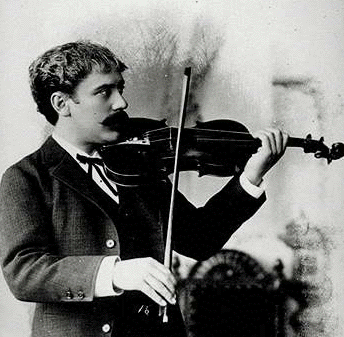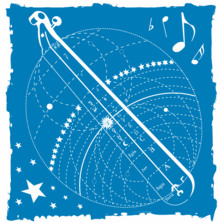Remembering September 11 - Playing Bach at Ground Zero
Yesterday marked the eighth anniversary of a horrific day in the United States and, I would imagine, well beyond our borders. Memories and emotions from September 11, 2001 streamed back – shock, helplessness, great fear, and an enormous numbing grief for those killed a mere few miles from my home.It began as a gloriously beautiful late summer day, with cloudless skies and a perfect temperature. Gradually, like countless others in Manhattan, I became aware of the sound of sirens filling the air and southbound traffic at a standstill. Throughout the city and the nation, we watched the televised news coverage with growing horror. The moment an aircraft hit the second tower, adjacent to the burning hell of the first, we collectively realized that this was no accident. Throughout New York, local firehouses sent their companies out with sirens screaming. In many cases, including the fire stations in my neighborhood, not a single firefighter returned alive.
Very oddly, I was virtually across the street from the World Trade Center the previous morning, Monday, on an errand. On Wednesday the stench of death reached my neighborhood: an acrid combination of smoke, melted plastics, paper, furniture and other countless materials that had been part of the World Trade Center, and over 2700 incinerated humans. Life had changed, indelibly. Both of my parents had recently passed away, my mother in February 2000 and my father in June 2001, but this deadening sorrow that I now felt well exceeded what I had experienced even at their deaths.
Ironically, invitations for performances came streaming in; partly because other artists were unable to travel. Flights were nonexistent, trains were virtually not running, and all of the local rental car companies had run out of available cars. A car service from Cape Cod was provided to take me up there – the same day I learned about the invitation – where I replaced Shlomo Mintz (who was stuck in Israel) as soloist in the Brahms Violin Concerto. I recall walking around Hyannis, still feeling stunned, and I cried as the orchestra played the “Star Spangled Banner” as I waited backstage to perform. The Metropolitan Museum asked me to play several concerts of solo Bach in its Medieval Court, to help soothe patrons who were understandably feeling skittish about being in any public venue in Manhattan.
A couple of weeks later, a friend called me and asked if I would be willing to play some quiet music for the rescue and recovery workers as they took their breaks in St. Paul’s Chapel. This chapel is an extraordinary place. Just a matter of yards away from the World Trade Center, its graveyard filled with debris from the collapsed towers yet the chapel itself was nearly undamaged. George Washington had worshipped there and his pew has a special place on the sanctuary’s northern side. I took the subway down with my violin – circuitously, because the direct line had suffered enormous damage and was closed – and walked over several blocks. As I got closer, streets were cordoned off and crowds, including tourists, were milling about, and the horrible smell increased. The trading center on Wall Street was draped in an enormous American flag and the streets were remarkably cleaned up of the debris, although it was clear that something catastrophic had occurred. The iron gates outside the church itself were covered in tributes and drawings by children, like a shrine, and in order to reach it I had to cross a barrier manned by the National Guard and local police. Because the church was being used as a sanctuary for the Ground Zero workers, it was off limits to the public. Inside was an extraordinary array of items: work boots neatly lined up, foot salves, socks, face masks, throat lozenges, sandwiches, snacks, and bottled water. Sleeping rolls and neatly folded donated comforters lined a number of the pews, and here and there a worker was stretched out resting. Several people were offering grief counseling to the recovery workers. (Although they were first called “rescue and recovery” workers, the term “rescue” had recently been removed as it became clear that there was no living souls left to rescue from the debris.) There were cots near George Washington’s pew, which was being used as a foot treatment center.
Working on the pile of rubble that had been the World Trade Center was extremely debilitating in every way. The debris burned for weeks afterwards and was hot even at the surface – hence the foot treatment center – and the air was laden with toxins even inside the sanctuary. The emotional consequences of encountering the human bodies and body parts must have been nightmarish, but the remains were carefully dug out for months afterward and always removed from the site with great gentleness. I was led to the front of the sanctuary, took out my violin, and began to play Bach. The sound resonated through the church and I recall hoping that it wasn’t disturbing the individuals who were trying to rest. I played the Adagio and Siciliana from the G minor sonata, the Sarabande from the D Minor partita, the Adagio from the C Major sonata, the Loure from the E Major partita. What felt best was the Andante from the A minor sonata; soothing, comforting, with an acknowledgement of tension in its middle section but ultimately ending in a calming and peaceful manner. Of all these beautiful movements, it was – and remains – the most consoling. After about an hour the church’s music director played some music on the piano and I walked around the sanctuary, settling down for a few minutes in a pew. Taped to the backs of the pews were dozens of drawings and encouraging words written by schoolchildren. Many of them praised the workers and featured a patriotic theme but one that seared itself into my mind – where it will always remain – showed the two towers themselves under attack, with anthropomorphic faces showing terror and arms hugging each other.
I was asked to return the next day, which was my birthday, and there was no other place I wanted to be. This time I was more careful about my selections, wanting to play music that was soothing and not revealing the grief that we all felt, but the day itself was even more challenging. At first, workers came in for breaks from their labors, including several dogs wearing special heat-resistant boots on their paws. Then the bodies of five firefighters were discovered in what had been a stairwell and I witnessed a number of visibly disturbed workers coming into the sanctuary, guided by a church volunteer, where they lit candles in front of where I played and were counseled.
As I left about an hour later, I walked back towards the subway and briefly turned to face west, where I saw the collapsed towers for the first time. It was an overwhelming sight. Seeing my response, an official came over to comfort me, asking if I wanted to speak with a counselor, which I appreciatively declined.
On November 1, 2001, the newly-formed Music of the Spheres Society gave its first concert. We donated all of the proceeds to two neighborhood firehouses that had suffered devastating losses, to be distributed among the families of the dead firefighters. It felt like the least we could do. Recently, at a post-concert “meet the artists,” audience members were encouraged to ask us questions, one of which was simple but ineffable: What does it feel like to play this music? This is nearly unanswerable but I have resolved to try, through these postings. All I can conclude with, now, is that I hope it never again feels like it did eight years ago.



















